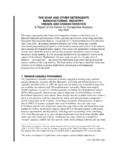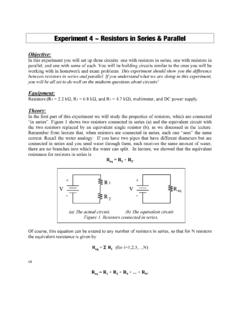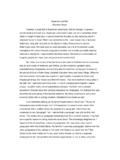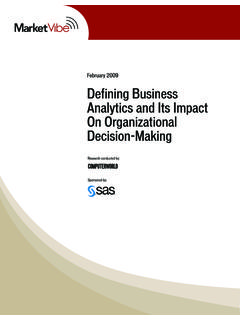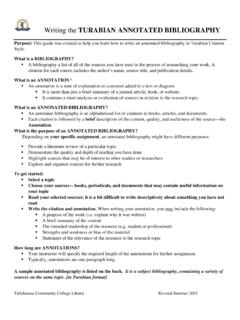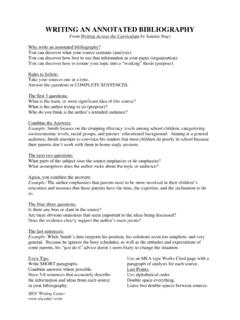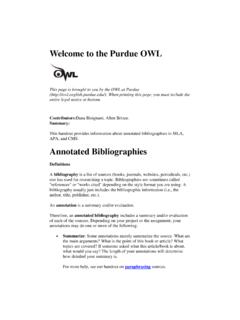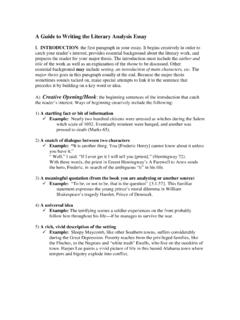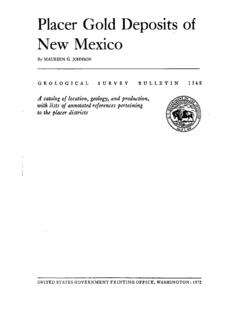Transcription of An Introduction to Content Analysis
1 An Introduction to Content AnalysisWriting@CSU: Writing GuideWriting@CSU Home Page | Writing Guides | Content Analysisl Main Pagel Introductionm Read a Brief History of Content Analysism Read about Uses of Content Analysism Types of Content Analysisl Conceptual Analysism Conceptual Analysis : Overview of Methodologym Conceptual Analysis : Steps for Conducting an Analysisl Relational Analysism Relational Analysis : Theoretical Influencesm Relational Analysis : Overview of Methodologym Relational Analysis : Steps for Conducting an Analysisl Examplesl Commentarym Issues of Reliability and Validitym Advantages of Content Analysism Disadvantages of Content Analysisl Key Termsl Related Linksl annotated BibliographyPrint-friendly FormatSite IndexSite InformationContact InformationContributorsAn Introduction to Content AnalysisContent Analysis is a research tool used to determine the presence of certain words or concepts within texts or sets of texts.
2 Researchers quantify and analyze the presence, meanings and relationships of such words and concepts, then make inferences about the messages within the texts, the writer(s), the audience, and even the culture and time of which these are a part. Texts can be defined broadly as books, book chapters, essays, interviews, discussions, newspaper headlines and articles, historical documents, speeches, conversations, advertising, theater, informal conversation, or really any occurrence of communicative language. Texts in a single study may also represent a variety of different types of occurrences, such as Palmquist's 1990 study of two composition classes, in which he analyzed student and teacher interviews, writing journals, classroom discussions and lectures, and out-of-class interaction sheets. To conduct a Content Analysis on any such text, the text is coded, or broken down, into manageable categories on a variety of levels--word, word sense, phrase, sentence, or theme--and then examined using one of Content Analysis ' basic methods: conceptual Analysis or relational Analysis .
3 L Read a Brief History of Content Analysis l Read about Uses of Content Analysis l Read about Types of Content Analysis (1 of 2) [10/11/2004 9:57:19 AM]An Introduction to Content AnalysisCopyright 1997-2004 (2 of 2) [10/11/2004 9:57:19 AM]A Brief History of Content AnalysisWriting@CSU: Writing GuideWriting@CSU Home Page | Writing Guides | Content Analysisl Main Pagel Introductionm Read a Brief History of Content Analysism Read about Uses of Content Analysism Types of Content Analysisl Conceptual Analysism Conceptual Analysis : Overview of Methodologym Conceptual Analysis : Steps for Conducting an Analysisl Relational Analysism Relational Analysis : Theoretical Influencesm Relational Analysis : Overview of Methodologym Relational Analysis : Steps for Conducting an Analysisl Examplesl Commentarym Issues of Reliability and Validitym Advantages of Content Analysism Disadvantages of Content Analysisl Key Termsl Related Linksl annotated BibliographyPrint-friendly FormatSite IndexSite InformationContact InformationContributorsA Brief History of Content Analysis Back to Introduction to Content Analysis Historically, Content Analysis was a time consuming process.
4 Analysis was done manually, or slow mainframe computers were used to analyze punch cards containing data punched in by human coders. Single studies could employ thousands of these cards. Human error and time constraints made this method impractical for large texts. However, despite its impracticality, Content Analysis was already an often utilized research method by the 1940's. Although initially limited to studies that examined texts for the frequency of the occurrence of identified terms (word counts), by the mid-1950's researchers were already starting to consider the need for more sophisticated methods of Analysis , focusing on concepts rather than simply words, and on semantic relationships rather than just presence (de Sola Pool 1959). While both traditions still continue today, Content Analysis now is also utilized to explore mental models, and their linguistic, affective, cognitive, social, cultural and historical significance. (1 of 2) [10/11/2004 9:57:52 AM]A Brief History of Content AnalysisCopyright 1997-2004 (2 of 2) [10/11/2004 9:57:52 AM]Uses of Content AnalysisWriting@CSU: Writing GuideWriting@CSU Home Page | Writing Guides | Content Analysisl Main Pagel Introductionm Read a Brief History of Content Analysism Read about Uses of Content Analysism Types of Content Analysisl Conceptual Analysism Conceptual Analysis : Overview of Methodologym Conceptual Analysis : Steps for Conducting an Analysisl Relational Analysism Relational Analysis : Theoretical Influencesm Relational Analysis : Overview of Methodologym Relational Analysis .
5 Steps for Conducting an Analysisl Examplesl Commentarym Issues of Reliability and Validitym Advantages of Content Analysism Disadvantages of Content Analysisl Key Termsl Related Linksl annotated BibliographyPrint-friendly FormatSite IndexSite InformationContact InformationContributorsUses of Content Analysis Back to Introduction to Content Analysis Perhaps due to the fact that it can be applied to examine any piece of writing or occurrence of recorded communication, Content Analysis is currently used in a dizzying array of fields, ranging from marketing and media studies, to literature and rhetoric, ethnography and cultural studies, gender and age issues, sociology and political science, psychology and cognitive science, and many other fields of inquiry. Additionally, Content Analysis reflects a close relationship with socio- and psycholinguistics, and is playing an integral role in the development of artificial intelligence. The following list (adapted from Berelson, 1952) offers more possibilities for the uses of Content Analysis : l Reveal international differences in communication Content l Detect the existence of propaganda l Identify the intentions, focus or communication trends of an individual, group or institution l Describe attitudinal and behavioral responses to communications l Determine psychological or emotional state of persons or groups Please see the Examples folder for more examples of Content Analysis in use.
6 (1 of 2) [10/11/2004 9:57:56 AM]Uses of Content AnalysisCopyright 1997-2004 (2 of 2) [10/11/2004 9:57:56 AM]Types of Content AnalysisWriting@CSU: Writing GuideWriting@CSU Home Page | Writing Guides | Content Analysisl Main Pagel Introductionm Read a Brief History of Content Analysism Read about Uses of Content Analysism Types of Content Analysisl Conceptual Analysism Conceptual Analysis : Overview of Methodologym Conceptual Analysis : Steps for Conducting an Analysisl Relational Analysism Relational Analysis : Theoretical Influencesm Relational Analysis : Overview of Methodologym Relational Analysis : Steps for Conducting an Analysisl Examplesl Commentarym Issues of Reliability and Validitym Advantages of Content Analysism Disadvantages of Content Analysisl Key Termsl Related Linksl annotated BibliographyPrint-friendly FormatSite IndexSite InformationContact InformationContributorsTypes of Content Analysis Back to Introduction to Content Analysis In this guide, we discuss two general categories of Content Analysis : conceptual Analysis and relational Analysis .
7 Conceptual Analysis can be thought of as establishing the existence and frequency of concepts most often represented by words of phrases in a text. For instance, say you have a hunch that your favorite poet often writes about hunger. With conceptual Analysis you can determine how many times words such as hunger, hungry, famished, or starving appear in a volume of poems. In contrast, relational Analysis goes one step further by examining the relationships among concepts in a text. Returning to the hunger example, with relational Analysis , you could identify what other words or phrases hunger or famished appear next to and then determine what different meanings emerge as a result of these groupings. To read more about each type of Content Analysis , click on the items below:l Conceptual Analysis l Relational Analysis (1 of 2) [10/11/2004 9:57:58 AM]Types of Content AnalysisCopyright 1997-2004 (2 of 2) [10/11/2004 9:57:58 AM]Conceptual AnalysisWriting@CSU: Writing GuideWriting@CSU Home Page | Writing Guides | Content Analysisl Main Pagel Introductionm Read a Brief History of Content Analysism Read about Uses of Content Analysism Types of Content Analysisl Conceptual Analysism Conceptual Analysis : Overview of Methodologym Conceptual Analysis : Steps for Conducting an Analysisl Relational Analysism Relational Analysis : Theoretical Influencesm Relational Analysis : Overview of Methodologym Relational Analysis .
8 Steps for Conducting an Analysisl Examplesl Commentarym Issues of Reliability and Validitym Advantages of Content Analysism Disadvantages of Content Analysisl Key Termsl Related Linksl annotated BibliographyPrint-friendly FormatSite IndexSite InformationContact InformationContributorsConceptual AnalysisTraditionally, Content Analysis has most often been thought of in terms of conceptual Analysis . In conceptual Analysis , a concept is chosen for examination, and the Analysis involves quantifying and tallying its presence. Also known as thematic Analysis [although this term is somewhat problematic, given its varied definitions in current literature--see Palmquist, Carley, & Dale (1997) vis-a-vis Smith (1992)], the focus here is on looking at the occurrence of selected terms within a text or texts, although the terms may be implicit as well as explicit. While explicit terms obviously are easy to identify, coding for implicit terms and deciding their level of implication is complicated by the need to base judgments on a somewhat subjective system.
9 To attempt to limit the subjectivity, then (as well as to limit problems of reliability and validity), coding such implicit terms usually involves the use of either a specialized dictionary or contextual translation rules. And sometimes, both tools are used--a trend reflected in recent versions of the Harvard and Lasswell dictionaries. l Conceptual Analysis : Overview of Methodologyl Conceptual Analysis : Steps for Conducting an (1 of 2) [10/11/2004 9:58:04 AM]Conceptual AnalysisCopyright 1997-2004 (2 of 2) [10/11/2004 9:58:04 AM]Methods of Conceptual AnalysisWriting@CSU: Writing GuideWriting@CSU Home Page | Writing Guides | Content Analysisl Main Pagel Introductionm Read a Brief History of Content Analysism Read about Uses of Content Analysism Types of Content Analysisl Conceptual Analysism Conceptual Analysis : Overview of Methodologym Conceptual Analysis : Steps for Conducting an Analysisl Relational Analysism Relational Analysis : Theoretical Influencesm Relational Analysis : Overview of Methodologym Relational Analysis .
10 Steps for Conducting an Analysisl Examplesl Commentarym Issues of Reliability and Validitym Advantages of Content Analysism Disadvantages of Content Analysisl Key Termsl Related Linksl annotated BibliographyPrint-friendly FormatSite IndexSite InformationContact InformationContributorsMethods of Conceptual AnalysisConceptual Analysis begins with identifying research questions and choosing a sample or samples. Once chosen, the text must be coded into manageable Content categories. The process of coding is basically one of selective reduction. By reducing the text to categories consisting of a word, set of words or phrases, the researcher can focus on, and code for, specific words or patterns that are indicative of the research question. An example of a conceptual Analysis would be to examine several Clinton speeches on health care, made during the 1992 presidential campaign, and code them for the existence of certain words. In looking at these speeches, the research question might involve examining the number of positive words used to describe Clinton's proposed plan, and the number of negative words used to describe the current status of health care in America.
